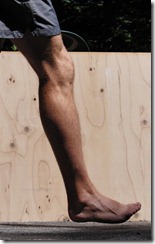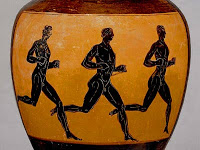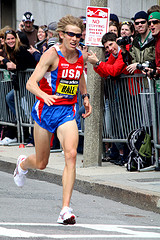 Today on the Peak Performance blog Amby Burfoot discusses a new study by a research team at the University of Massachusetts headed up by running biomechanist Dr. Joseph Hamill (see abstract here). The study is an interesting contribution to our knowledge of how running shoes affect the way we impact the ground while we run, and adds to the growing base of literature showing that running barefoot reduces both peak impact forces and loading rate (how fast the foot impacts the ground) relative to running in shoes. Increased loading rate has been linked to injuries such as stress fractures.
Today on the Peak Performance blog Amby Burfoot discusses a new study by a research team at the University of Massachusetts headed up by running biomechanist Dr. Joseph Hamill (see abstract here). The study is an interesting contribution to our knowledge of how running shoes affect the way we impact the ground while we run, and adds to the growing base of literature showing that running barefoot reduces both peak impact forces and loading rate (how fast the foot impacts the ground) relative to running in shoes. Increased loading rate has been linked to injuries such as stress fractures.
What Hamill and colleagues did was to take a group of ten runners who were heel strikers and have them run across a force plate 10 times in each of four footwear conditions. Three of these were 4mm drop shoes (i.e., 4mm heel lift relative to the forefoot) that varied only in the total thickness of the midsole cushioning (all had a thin outsole). In other words, the shoe conditions were as follows in terms of midsole cushion: 4mm heel, 0mm forefoot; 12mm heel, 8mm forefoot; 20mm heel, 16mm forefoot. The fourth condition was to have the runners go barefoot. None of these runners appear to have been habitual minimalist or barefoot runners, so the study is basically looking at how a runner used to running in a typical modern shoe changes when they go to a 4mm drop shoe (of varying midsole configuration) vs. barefoot. This is short term, immediate change as the runners did not run for an extended period of time to acclimate themselves in any of these shod or unshod conditions (acclimation was only 5-10 minutes prior to data collection).
What the authors found was that impact characteristics and knee/ankle stiffness did not vary among the 3 shod conditions. The runners all remained heel strikers in the 3 iterations of the 4mm drop shoes, though details of gait kinematics such as stride rate, length, etc. were not reported. However, when running barefoot, which presumably was a novel behavior for these runners, they adopted a midfoot/forefoot strike (I was a bit confused by how they define midfoot since they talk about the foot contacting on the midfoot after which the heel comes down – I tend to think of midfoot being simultaneous contact of heel and the base of the fifth metatarsal). Associated with this is the fact that impact peak and loading rate were significantly reduced, time to reach impact peak decreased, and ankle stiffness increased in the barefoot condition.
So what does all of this mean? Basically, if you have been running with a heel striking gait in traditional modern shoes, it is unlikely that going to a 4mm drop shoe will immediately cause you to lose your heel strike. However, going barefoot will cause you to adopt a very different running style whereby you lose the heel strike and adopt impact moderating behaviors (e.g., a different footstrike) that reduce peak impact force and the speed with which the foot collides with the ground. These are not entirely surprising results to anyone who has tried running barefoot on a hard surface, but do add to the growing literature showing that running barefoot is very different than running in a shoe with a cushioned heel lift. Whether or not these changes are linked to injury reduction is an open question, and it is possible that a midfoot/forefoot stride could simply shift primary injury locality away from the knee (minimalist runners often report that changing style helps with knee pain) and to the Achilles/calf, ankle, and foot, particularly among those not acclimated to running with barefoot mechanics.
What the study does not tell us is whether running in the shoes with the 4mm drop midsole would cause changes in gait over a longer period of time. Most runners who have gone to a more minimalist shoe report that gait change takes time, and that shoes with a lower heel facilitate a change in gait. It doesn’t happen immediately, as this study demonstrates, but it would be interesting to see if patterns changed if these runners were to run exclusively in a 4mm drop shoe for say 6 months. Many so-called minimalist shoes coming out have adopted a 4mm drop midsole or something close to that (e.g., NB Minimus, Saucony Kinvara, Mirage, Fastwitch, etc.), and thus information on potential changes with long term acclimation is much needed.
Perhaps the biggest take-home message from this paper is that if you want to get a handle on what more natural running feels like, simply take off you shoes and try running barefoot. Barefoot and minimalist runners often say that the best way to work on gait change, should that be your goal, is to start by running barefoot, and once you learn the barefoot stride it will be retained when you start running in shoes. I tend to agree with this given my own experience, though I did most of my form work in the Vibram Fivefingers. I can now run quite comfortably in 4-6mm lift shoes with a midfoot stride, but it was a long process to get to that point, and reprogramming stride can take quite a long time.
All in all, this was a cool little study with a simple hypothesis and fairly straightforward results. Like other studies have, it demonstrates that barefoot running is different than running in shoes, and that impact parameters change when shoes are removed. Does it mean we should all be running barefoot all the time? Of course not! That might work for some, but it’s impractical for others, including me when dealing with 3+ months of ice covered sidewalks and roads as I have this winter. I personally am not a regular barefoot runner, but have done so on a few occasions (up to 2 miles on asphalt) and can attest that it is very different than running in shoes. We still have a lot to learn, but it’s good to see scientists addressing these questions, and this paper was a nice contribution.
As is typical of just about any scientific paper, I’m left with more questions than answers after reading this one, but such is the nature of research. Among the things I’d like to know:
1. What would have happened if the runners ran in a typical shoe with a 12mm heel lift? Would this have differed than the 4mm drop shoes?
2. Extending the previous thought, I’d like to see shoes of varying heel lift tested so as to see if there is a threshold below which gait does change in a heel striking runner. Do you have to go all the way to barefoot? Other studies have shown that shoes like the Vibram Fivefingers do a reasonable job of simulating barefoot mechanics (Squadrone and Gallozzi, 2009), so it would be interesting to see at what point we lose that similarity as we modify midsole properties.
3. How would the results of this study vary if habitual minimalist/barefoot runners were tested?
4. As discussed above, how does acclimation affect the results? All too often studies like this are done by exposing heel striking runners a novel condition (low drop shoe, barefoot) and asking them to run without acclimating to the novel condition. The results of this study show that running barefoot results in almost immediate changes, but even the barefoot runners in this study produced an impact peak, which is typically not the case for habitual barefoot runners such as those examined by Lieberman et al., 2010. Clearly a motor learning process must be involved, and this needs to be studied in more detail.

















Similar to what you point out in your analysis points 1 & 2 I would like to see what the results would be with a variety of zero drop footwear instead of maintaining a drop across all footwear. How much different would the study then become?
I like your number 3 question
3. How would the results of this study vary if habitual minimalist/barefoot runners were tested?
I would have also liked to see these runners in two zero drop shoes one with cushioning and one without like a KSO
I run in vibrams and running sandals back to back. I can tell you that there is more support in those vibrams than I would have thought. Even though it is little more than fabric, there is quite a bit of constriction that comes into play when your toes want to splay. The Luna Sandals allow for that while affording rock protection. Great write up!
What the study is missing is what happens after short term acclimation. For example, if I spend two weeks running barefoot and then go shod, what happens? I can tell you what happens with me (and obviously I am not representative of any number of runners), I revert back to a heel strike. Even if I put on a pair of Vibrams, I still heel strike once the foot is covered, regardless of the drop. Admittedly, I am slow on the uptake, but this does support the notion (which you have put forth many times over) that gait change is not a short term proposition, but something that requires time and focus. On the other hand, terrain may also factor into what happens. Taking the example of the Vibrams again, if I wear Vibrams on a trail, I am more apt to run with a barefoot stride/gait, than my typical heel triking gait.
I have had some odd experiences lately when switching between NB Minimus Road and VFF Bikila. I’ve been running in the Bikila for about 10 months, and I’ve put over 300 miles on them. They were my introduction to forefoot running, and I adapted pretty quickly. I run almost exclusively in them. I just picked up the Minimus last week, and I can’t seem to find my forefoot in them. I did 7+ miles in them on Monday night and was so frustrated with the experience that when I got home I put on the Bikilas just to finish the night with that “one good mile” feeling. The transition was surprisingly difficult. The Bikilas were as awkward as they had been the first time I wore them, and my feet felt incredibly tender. I had to really focus on my form for a quarter mile or so before I could really get into the run.
All that to say, I think that there’s more to consider than simply the heel-forefoot drop. I think that there is a total heel height threshold (regardless of forefoot drop) at which the shoe “intercepts” a forefoot or even midfoot landing.
I think the overall sole thickness is important to mimicking the feel of being barefoot, which is why VFF’s do such a great job of teaching midfoot mechanics – there’s no heel-toe drop but more importantly the sole is incredibly thin.
Regarding your third question, my intuition tells me that habitually minimalist runners would probably have a more midfoot strike. This subgroup of runners is likely concerned with form and have changed their foot strike since going minimalist. I’d love to see a study on this.
I recently switched from VFF Sprints to Merrell Trails. I didn’t have to think about a midfoot strike with my Sprints. It just happened. But I think I fell right back to a heel strike in the Trails. I presume there is enough of a outsole on the Trails that a heel strike is not immediately painful. As such, my old knee pains have come back. I did a run this morning in my Trails where I really focused on form (including carrying along a metronome to force the right pace.) I did find that a midfoot strike was not natural with my Trails and I had to focus.
The Trails are zero drop. As such, I agree with other posts that suggest that the heel drop may be less important than the sole thickness.
Interesting thoughts. I personally find drop to make a big difference, but
absolute thickness can as well. I can run midfoot in a lot of shoes, but it
may be because I am constantly varying what I run in due to my reviewing and
thus can shift easily from shoe to shoe. I found that even a zero drop shoe
with a thick sole like the GoLite Amp allowed a fairly natural midfoot
stride. In the Vibrams, however, I think I mostly run on the forefoot, and I
think the Merrells are pretty similar for me. May be a case of a lot of
individual variation.
Pete
I’m sure that is correct. And maybe variations in experience. My Sprints have a particularly thin sole. I can really feel the ground. I tell folks that wearing my Sprints feels just like barefoot but less danger of cuts & scrapes. As such, I am feel forced to adopt a soft strike. With my Trails, I feel a lot less ground. From a ground sensation standpoint, they feel like regular shoes. At least right now, while they are still new. As such, I think it is easier for a newbie like me to fall back to my old stride, even with a zero drop.
Or maybe not. I’m just making this up as I go along. I’m quite ready to defer to Dr. Pete!
I agree with you – ground feel is better in my KSO’s or Bikilas than it is
in the Trek Sport or Merrells. But all of these are better than just about
anything else that I have. Lots of gradations out there, and they all impact
form to some degree I think.
Pete
I suspect that sole flexibility may play a role as well. Both KSO and Bikila are hyperflexible. I haven’t played with the TrekSport or new Merrells, but my guess is that they are less so. I wonder how much of a forefoot/soft strike is affected by the (in)ability to shape your foot as you land.
Hi Pete,
I tend to agree with your experience. I too run in a lot of different shoes and can run with a midfoot strike in all of them, but when I wear my VFF’s or the EVO’s I tend to feel myself touching down on my forefoot and then immediately going to the midfoot stance for the support phase of the stride. Where I notice the difference most is on downhills. When I’m in zero drop shoes I always have shift my landing to a more forefoot strike because of the impact of running downhill. In the more traditional running shoes I can run much faster downhills because the cushioning effect of the extra heel height helps to dissipate the impact of the landing. I’d have to say that racing in zero drop minimalist shoes has the effect of slowing me down. For faster running I resort to my favorite racing flats (Mizuno Wave Universe III). Thanks for posting this study. Every little bit helps to educate people to make better choices.
Thanks Danny – I agree on downhill running. I find it very hard to run fast
on downhills in Vibrams or other barefoot style shoes, and it does require
an alteration of footstrike to do it effectively. Conversely, I find running
uphill to be easier in the Vibrams. All very interesting…
Pete
I only read the abstract, but I found it interesting that “For impact peak, ankle stiffness and knee stiffness, there was no difference among the shod conditions”. I know it has been discussed before, but it shows that there is no point to big cushioned shoes.
Of course, these were not long runs. While there may be little/no measurable benefit to the knees and ankles at impact peak, I think that there may still be a benefit to the feet for some (minimal and strategic) cushioning on longer runs. I’ve put hundreds of miles on my VFF Bikila, and I totally love them, but after 9-10 miles on pavement, there is definitely some serious tissue tenderness.
I tend to agree – for long runs or speedwork I prefer a little cushion as
well.
Pete
Pete,
Not sure if you’ve already addressed this but it would be interesting to see what the amount of increased workload on the ankle/foot and its related force is in comparison to the lesser workload and related force on the knee/hip force as they both relate to their injury rate in each approach of running (shod vs. unshod)(cushioned vs. unchusioned), etc,.
It’s a good question – have not written about this type of comparison. The difficult part is that in any study like that you have people who are adapted to one strike type or the other, so having them switch can provide misleading results.